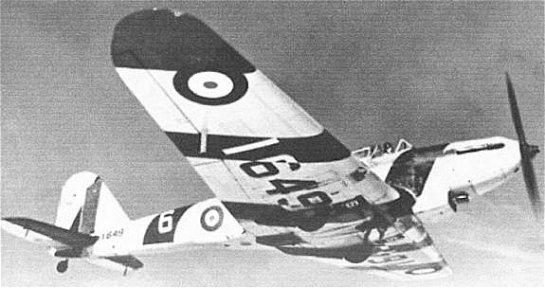
Fairey Battle. Saw action in France 1939/40,
also used in Gunnery Training
Hatch to Gunner’s cockpit in belly immediately
behind wing.
An 'Ole in the Battle's
Belly
(With apologies to "There’s
a hole in the bucket dear Liza, dear Liza.")
There’s a cold draft coming up me
turret dear Harry, dear Harry,
A draft.
‘Cause there’s an ‘ole in the Battle’s
belly dear Willy, dear Willy,
An ‘ole.
Since your down there below, please
stuff it dear Harry, dear Harry,
Stuff it.
And just how do you suggest I stuff
the ‘ole dear Willy, dear Willy,
Just how?
Just reach down and close the bloody
hatch dear Harry, dear Harry,
Close it.
But there’s just no bloody hatch
to close my dear Willy, dear Willy,
No hatch.
Why do I feel I’m going to barf
on your head dear Harry, dear Harry,
Barf.
‘Cause there’s an ‘ole in the Battle’s
Belly dear Willy, dear Willy,
An ‘ole.
~ J. Selyom.
Air
Gunner’s Training Trilogy
Waltz of Death
or
The ‘Ole in the Belly of the
Battle’
by Don Daikins
Short Burst March 1993 Issue #41
The ‘ole in the belly of the Fairey
Battle was where we gunners entered and exited that old bucket of bolts.
By the time I arrived at #3 B&G
MacDonald, Manitoba, the Battles were fitted with Boulton Paul turrets
the same as what the Hally’s had on Ops. They had four Browning .303’s
just like the big boys.
The “hole” was fitted amidships
between the wings and we clambered up through that hole and into a more
or less “rest position” where one gunner sat while the other gunner
was in the turret firing at the drogue. That “hole” was originally fitted
with a hatch cover that opened down and towards the front of the aircraft.
Most Battles had, upon my arrival in 1943, lost the cover and all that
was left was the “hole”.
The “rest” position was a cramped
area just ahead of a main spar that we sat on while waiting our turn to
enter the turret. The whole area was polished smooth from many thousands
of asses reclining on it and one slid in all directions in turbulent weather.
As you sat on the spar you could look down through the hole and see what
was coming towards you from down below.
I flew with a young fellow by the
name of DAG, alphabetically ahead of DAIKENS and he was airsick from the
time we took off until we landed. These aircraft had a goodly supply of
waxed cartons to “BARF” into and good old DAG used all of his and all of
mine.
As I sat on the spar he would kick
my shoulder and I would reach up behind me, grab a nice warm carton
of puke and, having no place to dispose of it, I casually bombed any and
all cattle, humans, houses, cars, or whatever, as they came into view down
below.
The position was very dangerous
as the hole was large enough to fall out of. Just before my arrival a Gunner
had fallen out of the hole as the Battle was preparing to land.
The fun started when we had to change
positions. The upper gunner kicked the guy down below who more or less
stood up and started to shuffle around the hole while the other gunner
slid down and stepped onto the spar. We hung on to each other’s shoulders
as we circuited the hole, as there was nothing else to hang onto. This
manoeuvre continued while we both made a circuit of the hole and the opposite
gunner got into position to climb up into the turret.
We called it “The Waltz of Death”.

Fairey Battle 1941 #2 B&G
Mossbank, Sask.
Note open cockpit. The Gunner
is wearing a winter service hat which was fondly referred to as a “piss
pot”.
At that time helmets were in
short supply and one wore what was available.
John Moyles
These aircraft had seen service
in France before Dunkirk. Some of the Staff Pilots had flown them in combat.
I didn't realize this until I asked a Pilot why there were square riveted
patches on the fuselage. He replied, "bullet holes." This brought
the war a little closer. (See article below, Canada's First
D.F.M. WWII)
Unlike the Battles at MacDonald
#3 B&G, enjoyed by Daiken, we had no turret, just an open cockpit with
a single free .303 Vickers gas operated machine gun on a scarf ring. One
Gunner stood up behind the gun while the second Gunner hunkered down on
the floor with his feet braced on either side of the "hole" in the belly,
landscape flew by underneath, fumes and exhaust swept back and up through
the hole, many a meal was spread over the prairies.
One cold November day in 1941, we
took off for an exercise. I was on the floor watching the runway rush by
under my feet. 500 feet off the end of the runway a glycol coolant line
ruptured, spraying glycol over the pilot’s windscreen. Unable to see, he
put on his goggles, pushed back the canopy and stuck his head out as he
started his turn back to the airport. His goggles immediately covered with
glycol. He pulled off his goggles and got the full force of the hot fluid
on his eyes rendering him blind.
By this time we were letting down,
wheels up, approaching the runway at a ninety-degree angle. Huge drifts
of snow paralleled each runway. The Battle hit the first drift belly
first ploughing snow up through the hole and forcing me up beside the other
Gunner. The aircraft jumped the runway, hit the opposite snow bank forcing
in more snow and almost pushing us both out of the cockpit. The aircraft
slid to a stop in a nose down, tail up attitude. When the emergency crews
arrived we must have been a humorous sight. Two Gunners perched on top
of a snow filled cockpit, and the pilot, completely blind, staggering around
in the snow,
The Pilot spent a week in hospital
but returned to the flight line. He was known as the man with the well-oiled
eyeballs. It was the cushion of snow in the gunner’s cockpit that saved
us from injury.

O'Henry Chocolate Bars have
a lot of Peanuts
or
Bird Hits Fairey Battle
By Stanley P. Orien
Mont Joli, July, 1943. As we waited
in the hangar for our turn to take off on a gunnery exercise, I consumed
two O’Henry bars and drank a Coke. That trip I was second gunner and I
was down over the hole while my partner was up in the turret.
Until we got into the air, the fuselage
compartment was very hot. There was a strong smell of fuel and glycol and
a previous Gunner’s vomit. By the time we got up to height, I was very
very close to bringing up. I knew that I didn’t stand a chance of holding
it down.
Without hesitation, off came my
parachute harness, and the shirt I was wearing over a tee shirt. Not too
soon, everything started to come up, the O’Henry bars, the Coke, my lunch,
and almost my insides, ended up in the shirt. Everything happened very
quickly. I threw shirt and contents out the hole in the belly of the aircraft.
I was safe. I would not have to spend an hour scrubbing the inside of the
aircraft, all had been blown away in the slipstream.
At that particular moment our drogue
plane, another Fairey Battle, was passing behind our aircraft to get into
position for the exercise. My partner in the turret came on the intercom,
“hey, our drogue plane has just hit a bird. It’s splattered all over the
front of his windshield. It looks like he is heading back to the airport.”
The radio came to life and the pilot
from the drogue aircraft said, “I think I just hit a bird or something.
There doesn’t seem to be any damage but I better get the aircraft checked
and cleaned. I’ve got all this muck splattered over my windshield. I’m
returning to base.”
There was great excitement when
we got back to base about a drogue plane hitting a bird, how badly it had
been splattered, stank, and that the bird must have been eating peanuts,
or something that looked like peanuts.
No one ever knew what really happened,
and I never said a word to anyone. My instructor gave me hell for wearing
just a tee shirt.
No.
2 Bombing and Gunnery School Mossbank Sk.
The Birth of a Training base
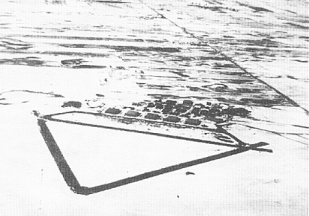
#2 B&G Mossbank, Sk. 1940. Mossbank grain elevators
upper right.
Forty-six buildings at a cost of $800,000 and airfield
construction of $330,890 made this airdrome and school in excess of a million
dollars. Six 224 by 180 foot hangars, some 40 other buildings, three triangular
runways of 2500 feet in length and 150 feet wide, and storage facilities
for 21,000 gallons of aviation fuel describe the size of the unit. Foundation
work was underway by mid May 1940.
No one source for the 50,000 gallons of water estimated
for the station’s daily needs had been found. Test wells were being drilled.
In November 1941 the water supply was transported from wells through above-ground
insulated pipes. These pipes were continually freezing in the severe prairie
winter temperatures. For days personnel had to melt snow on the barracks
coal stove for drinking, shaving and washing. Septic tanks were required
for the station sewer systems. Due to frozen pipes the out door earth pit
toilets were constantly called into service.
On October 23, 1940 the Adjutant, F/O Ransom, published
a warning in DRO’s to be aware of the deep sewer and water trenches about
the camp. There were no streetlights at night and considerable distances
to travel from barracks to mess hall. Ironically F/O Ransom fell into a
trench and broke his leg. With the aid of flashlights personnel removed
him from the trench and his leg was set and placed in splints on an ordinary
barracks bed. There he rested until he could be moved to hospital in Regina.
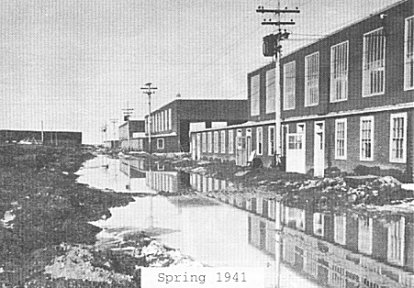
The Unit officially opened without fanfare or ceremony
on October 28, 1940. The first three Fairey Battles had arrived October
24 followed by others until the complement was up to 50 by January, 1941.
A class of Air Gunners and Bomb Aimers were to begin their
training on October 28th., 1940, but there was no equipment or training
manuals for either course, not even a duplicating machine for making manual
copies. Lectures were further complicated by the lack of electric lights
in the Ground Instructional School. On November 7, electric lights became
available. Training flights could not be commenced due to lack of equipment.
On November 4 a gas operated machine gun was borrowed from a Regina Unit.
There was no flying kit or helmets fitted with inter-communication apparatus.
Several camera guns and Browning machine guns arrived – less breach blocks,
and no ammunition. There was only one bombsight and when practice bombs
arrived they had no detonators. Armourers had to work in unheated
hangars in below zero temperatures.
Station Daily Diary, November 27. “No breaches for Browning
guns, no ammunition, no gun mounting blocks, no magazines for gas operated
machine guns. No. 1 Course on their third week of training and still have
had no air firing.” Station Diary November 29. “The Courses are up to schedule
not withstanding shortages of equipment, due largely to the ingenuity of
the officers in charge of the courses.”
Another Air Gunner course arrived without advance
notice and without documents. It is remarkable that none of these problems
postponed the graduation of the first course of Air Gunners on November
14th , 1940, and the first course of Air Bombers on December 9th. Both
Courses on schedule, just 8 months after breaking the Prairie sod.
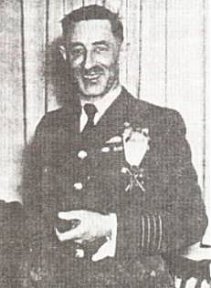
Group Captain A.J. Ashton arrived to command the new
school October 16, 1940.
In 1915 Ashton went overseas with Winnipeg’s 8th.
Battalion, the “Little Black Devils”.
In 1917 he transferred to the Royal Flying Corps.
He was among the first officers accepted in the RCAF
on its formation in 1921.
Canada’s
First D.F.M. WWII
Gordon Nelson Patterson
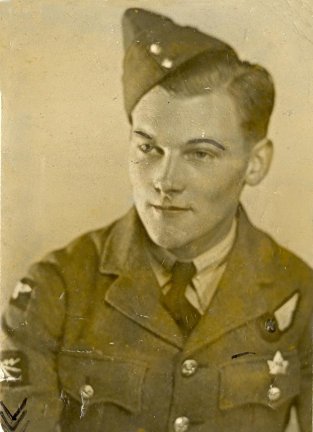 “The
Germans are advancing, the bridges have to be destroyed at all cost!”
“The
Germans are advancing, the bridges have to be destroyed at all cost!”
What was left of Fairey Battle Squadron No. 12 was lined
up to hear the C.O. give the bad news. It was May 12, 1940 at Aminfontaine,
near Rheimas in Northern France that five bomber crews volunteered to make
the suicidal attack against the Maastricht Bridges on the River Meuse and
Albert Canal in Holland.
“Enemy flak is going to be heavy,” said the C.O., “and
there are masses of German fighters near the target. Take off is at 8:20.”
A.C.2 Gordon Patterson from Woodrow, Saskatchewan, was
the Wireless Air Gunner in one of the Fairey Battles. The Battle was a
reliable, easy to handle, aircraft, but it was slow, vulnerable, and under-armed
in combat. In fact it was obsolete even when the war began, but because
they had so many, and not enough better bombers, they were allowed to go
into battle.
As Gordon Patterson explained it, “my rear gun was a Vickers
gas operated pan-fed MG on a manually operated rocker mount, using ring
and bead sight. Our spring loaded pans held 100 rounds. If we wound the
springs up to 4 and ½ turns we got approximately 750 rounds per
minute. Six turns brought them close to 1000 RPM.
Patterson had joined the RAF in May 1938 after running
away from home at age 16 and working on steamers around the world. His
training included Morse code, 26 wpm, Semaphore 12 wpm, Aldis lamp 8 wpm,
plus gunnery training. He joined 12 Squadron as an Aircraftsman Second
Class, and the Squadron went to France September 2nd. 1939.
The five Battles took off and proceeded to target in one
flight of three and another flight of two. Patterson was in the second
flight. Other Canadians were in the attack. F/O Billy Brown from Macgregor,
Manitoba, P/O Roland Dibrah, Winnipeg, Manitoba, P/O Raymond Lewis, Vancouver,
British Columbia. The first three aircraft went in and were all shot
down after dropping their bombs. Two of that flight received the first
V.C.’s of the war.
Patterson states, “our flight went in at 9000 feet to
dive bomb the bridge. Our Flight Commander, F/O Thomas, hit the bridge
but was immediately shot down and all his crew captured. Before we could
dive we were attacked by three ME 109’s, which I eventually shot down,
but we were so badly damaged that our pilot , P/O Davey, ordered us to
bail out. I had been hit on my earpiece, in the right forearm, and left
leg. When I bailed out, I hit the tail and smashed up my right forearm.
I landed in the courtyard of the Hospital des Anglais in Liege, Belgium,
and was immediately taken into the hospital. The Germans entered the city
that evening and I became a Prisoner of War.”
Gordon was to experience time in 17 different PoW camps,
including a work camp in Poland. His imprisonment included the one month
march from Stalag 157, Poland, to Schwerin. He was released by the British
Airborne May 2nd. 1945, and arrived back in England VE Day. Gordon transferred
over to the RCAF with an effective transfer date back-dated to November
24, 1944, returned to Canada August 12, 1945, discharged October 20, 1945
as a WO 1
In 1945 a special investiture in Saskatoon, saw Governor
General Viscount Alexander present Gordon with Canada’s first D.F.M. –
just five years late.
Post war, Gordon went to University of Saskatchewan and
obtained a degree in Engineering. He rejoined the RCAF in 1948 serving
until 1966 as a Squadron Leader. Later, Gordon served on the faculty of
the Physics Department at the U of S. Saskatoon.
Gordon worked with the RCAF on the Avro Arrow and flew
in the B58 Hustler while it was under going flight testing to check out
telemetry equipment that would have been used during RCAF flight testing
at Cold Lake. Unfortunately, we all know what a big mistake the cancellation
was.
Gordon Patterson passed away in 1994. We will remember
him.
Photo and bio information has been updated by his eldest
son:
James P. Patterson
Cambridge Bay, NU
Belated
Awards from WWII
Weldy Moffatt
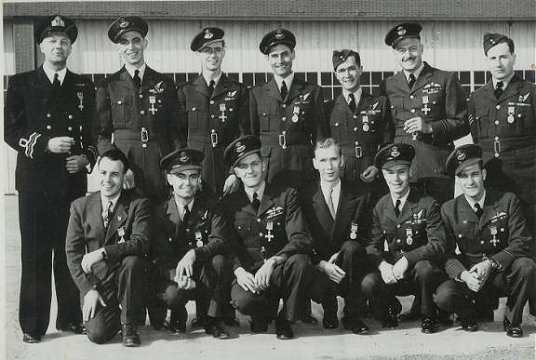
Individuals receiving awards September 1946, Saskatoon,
Saskatchewan.
Back row - Austen Astenson, J C Deutscher, B A M Fox,
D G Lightfoot, N C Currell, R W Moffatt
Front row: - C K Burliungame, F J Hutchings, J P Gracie,
D McDougal, J A P Stapleton, J A Kerr.
Deutscher stayed in Regina became a dentist and later
became a RC priest. Now retired
Moffatt stayed in Regina and worked for several employers
as an accountant
McDougal was son of Chief of Police in Regina and
worked with Imperial oil and transferred to Edmonton.
Stapleton worked with Kenridge on 11th Ave and later
with a national clothing manufacturer and was transferred to Alberta.
I did not want to write about the reason for my DFM because
the citation differs from the recommendation quite significantly and the
recommendation even differs from the circumstances. I learned that the
circumstances leading to a decoration can also lead to a courts martial.
So be it.
The award of my DFM was gazetted in April 1945 but my
first knowledge of it was when my parents received a letter from the Minister
of National Defence dated 29 November, 1945. I did not pursue the matter
at that time as I was expected to receive all my medals by mail following
the application that had been submitted. No further thought was given to
it until I received a letter inviting me to a medal presentation in Saskatoon
6 September 1947.
The recommendation: "Flight Sergeant Moffatt has completed
twenty-seven operations and one hundred and seventy-one hours operation
time on his first tour, completely on heavily defended German strategic
and mining targets. His work has been outstanding as wireless operator,
and his co-operation, coolness and devotion to duty has contributed in
a large measure to the many sorties he has completed. His operational dash
and cheerful confidence has instilled a high standard in his crew."
It took many years to find its true value as a memento
of my service. I now wear the medal with pride, after finding out how few
of this type were awarded. The original was stolen and when a replacement
was obtained I knew more about its monetary value.
First
Air Mail in Western Canada - Calgary to Edmonton
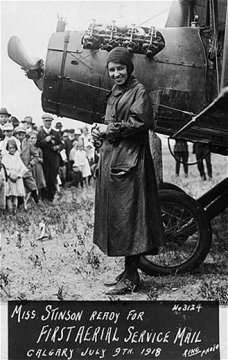
In 1918 Katherine Stinson announced
she would return to the Edmonton fair,
and while in Calgary she was
appointed an official mail carrier and handed a sack of first class mail.
The mail had been stamped 'Aeroplane
Mail Service, July 9, 1918'
MISS KATHERINE STINSON MAKES SUCCESSFUL
TRIP, CALGARY TO EDMONTON. That was the headline in the Edmonton
Journal on Wednesday, July 10, 1918. Katherine Stinson (1891-1977)
was an American pilot and the fourth woman in the US to earn a pilots license.
On July 09, 1918 Katherine Stinson
flew the first airmail delivery in western Canada on a flight from Calgary
to Edmonton, the flight lasting 125 minutes. She departed the Calgary
Exhibition grounds at 1305 hours but she had only travelled about nine
miles when she suffered some engine problems. She was forced to land
at a small station called Beddington near the site of the present Calgary
International Airport. There was no telegraph office at the station
so it was some time before she was able to contact her crew in Calgary.
She was finally able to make contact and her mechanics drove to the scene
where they commenced to work on the engine. The problems were finally
corrected in the late afternoon and the aircraft was pronounced serviceable.
Miss Stinson was anxious to keep
her record intact so she flew back to Calgary and once again set out on
her journey. About 1930 hours that evening the large crowd waiting
at the Edmonton Exhibition grounds got the word that she was safely on
her way. Like many a young airman 25 years later, she followed
the Canadian Pacific tracks, the "Iron Compass",, to her destination.
The Exhibition management was kept posted on her progress, as she passed
Red Deer, Lacombe, Wetaskiwin and Leduc, by the excellent bulletin services
of the CPR. They also got a good idea of how fast she was flying.
The aircraft finally came in sight flying from the south and, after circling
the grounds, Katherine landed in the centre of the infield at 2003 hours.
Mr. George Armstrong, Postmaster,
was on hand to receive the bag of mail, the first to be delivered by air
and containing 259 letters. Miss Stinson also conveyed greetings
from Mr. Freese the Acting Mayor of the City of Calgary, to Mr. H.M.E.
Evans, Chief Magistrate of the City of Edmonton. The flight took
two hours and five minutes of actual flying time. Katherine had previously
held long distance and endurance records for women , Chicago to Binghampton,
NY, 783 miles in 10 hours and 23 minutes for example.
A team of skilled volunteers at
the Edmonton Aviation Heritage Museum is nearing completion of an exact
replica of the Curtiss Special aircraft. (See the March Shortbursts).
On July 09, 2006 Katherine Stinsons record flight will be commemorated
when 259 letters will be flown from Calgary to Edmonton. The flight
is a joint effort by the Edmonton Aviation Museum Association and the western
chapter of the Canadian Aerophilatelic Society. The arrival in Edmonton
of this special flight will coincide with the unveiling of the replica
Curtiss Special. This event will be covered and hopefully an account
will appear, with photographs, in the September issue of Short Bursts.
This flight was of importance for
another reason, it was the first cross country flight in western Canada.
Until that day no one had made a flight of that distance in the west.
Some historians feel that this flight was just as important as the first
airmail flight if not more so.
I am indebted to Mr. John J.Chalmers
of Edmonton for his great assistance with this account.
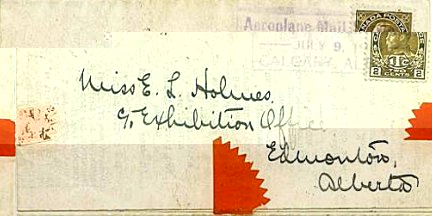
Stamp Cancellation: Aeroplane
Mail July 9, 1918, Calgary Alberta.
When famed American aviator Katherine Stinson
ordered a one-of-a-kind biplane from the Curtiss Aeroplane Company in 1917,
neither she nor company founder Glenn Curtiss could have had any idea that
the unique aircraft would be re-created in Edmonton nearly 90 years later.
Katherine Stinson (1891-1977) was the fourth American
woman to earn a pilot's license. She gained fame as a barnstormer and her
unique “Curtiss Special” aircraft was built for better aerobatic performance
than the famed Curtiss JN-4 “Jenny” and Curtiss S-3 Speed Scout triplane
on which her aircraft was modeled.
It had a single cockpit and Jenny wings, but with
the upper wing shorter on each side, and a bigger tail assembly than the
Jenny. The fuselage was based on the S-3 triplane, but extended in length.
The modifications were made to provide greater aerobatic performance in
her flying demonstrations.

Ready to leave Calgary on July 9, 1918
Building
a Biplane Barnstormer and Re-enacting Western Canada's First Air Mail Delivery
By John J. Chalmers
442 Reeves Crest, Edmonton, Alberta T6R 2A3. ph.
780-435-8194.
johnchalmers@shaw.ca
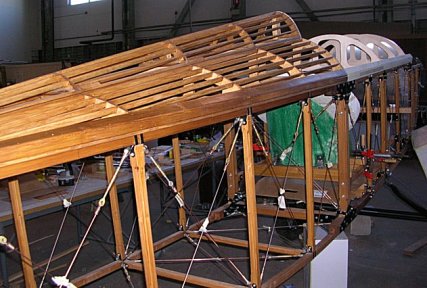
Today, a team of skilled volunteers at the Alberta Aviation
Museum are nearing completion of an exact replica of Stinson’s Curtiss
Special. The aircraft presented a special challenge to the volunteers in
the shop at the wartime hangar on Kingsway Avenue in Edmonton where the
museum is located. First, blueprints of the Curtiss Special could not be
found, so the craftsmen building the replica created their own drawings.
“Our biggest challenge was seeing how close we are to the original,” says
Jim Fearn, one of a dozen men who have been working on the project for
over two years. “All drawings and specifications were done here as a result
of group decisions,” he says. Working from photographs of Katherine Stinson’s
aircraft, they were able to design the wings and the larger tail assembly.
Thousands of volunteer hours have now been spent on the project.
Locating original parts was another challenge. The
museum obtained an original Curtiss “O-X” liquid cooled V-8 engine of the
type used by Curtiss in early biplanes. To complete the 536 cubic engine
that produced 100 horsepower, a search on the Internet was rewarded by
finding push rods and rocker arms for the valve assembly. A replica radiator
will be installed, but the wooden propeller is a Curtiss original, provided
by the Aero Space Museum in Calgary.
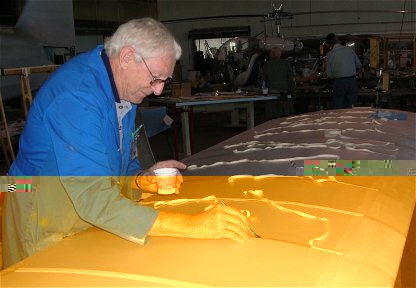
Gerry Blacklock adding protective tape prior to stiching
over the ribs on a wing now covered with fabric.
On July 9, 2006, a re-enactment of Katherine Stinson’s
airmail delivery, the first cross-country flight in Alberta, will be made
by flying 259 letters from Calgary to Edmonton. The event is a joint effort
of the western chapter of the Canadian Aerophilatelic Society (CAS) and
the Alberta Aviation Museum Association. The arrival in Edmonton will coincide
with the official unveiling of the Curtiss Special. The aircraft will then
officially join the collection of historic aircraft at the Alberta Aviation
Museum.
Lindsay Deeprose, restoration manager at the Alberta
Aviation Museum, has been a volunteer for 18 years and has worked on several
reconstruction projects. He says, “Restoring and displaying historic aircraft
retains the history of aviation in this part of our world for the people
of today and for future generations. A side benefit is keeping us doing
something constructive that we enjoy!”
Even the museum’s hangar itself is a museum piece,
built in 1941 for training purposes during the Second World War. At one
time it housed aircraft of the British Commonwealth Air Training Plan and
was post-war home to RCAF City of Edmonton 418 Squadron. Today a total
of 14 organizations share use of the hangar, all of which are related in
some way to aviation.
Nearly complete now, the aircraft will never fly,
but an electric motor hidden inside the engine crankcase will spin the
wooden propeller when this addition to aviation history makes its debut
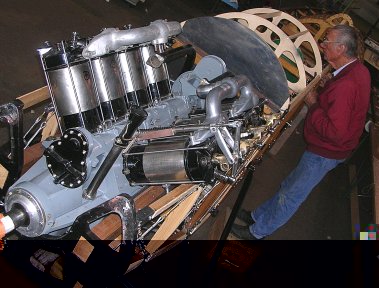
Re-enacting the Mail Delivery
On July 9 for the re-enactment flight, the 259
specially-stamped letters will arrive in a Cessna 172 flown by Audrey Kahovec.
At 29, she already has 900 hours of flying time and has been a licensed
pilot since she was 16.
While serving with Air Cadets in her native province
of Saskatchewan, she attained the rank of WO2 with No. 566 Squadron in
Canora, and won a scholarship that saw her rewarded with a gliding license
at 16. At 17, she was awarded another scholarship through cadets that enabled
her to complete a pilot’s license and now has been flying nearly half her
life.
Audrey also holds a commercial license with a night,
multi-engine and instrument rating and recently completed qualifications
for an instructor’s license. “I’ve been hooked on flying since my first
flight with an uncle who took me for a ride when I was a kid,” she says.
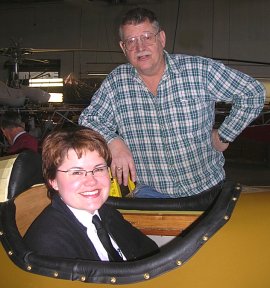
Audrey Kahovec gets checked out on the Curtiss Special
controls
by Jim Fearn, one of the volunteers who helped build
the aircraft.
On July 9 she will take time out from working as an instructor
with the Edmonton Flying Club to transport the mail in a route first done
by Katherine Stinson in her Curtiss Special on July 9, 1918.
Upon arrival in Edmonton, Audrey will then be seated
in the cockpit of the biplane for the roll-out of the replica built at
the Alberta Aviation Museum in Edmonton.
Audrey makes her home in St. Albert with her husband
Bud, and says she is honoured and privileged to participate in the re-enactment
event.
A splendid painting by Canadian artist Jim Bruce
has been created to commemorate the event. It shows the Curtiss Special
airborne from Calgary to Edmonton and will be on display at the museum,
with reproductions available for sale. Shown below are Lindsay Deeprose,
left, and Bob Busse, vice-president of the Alberta Aviation Museum Association.
High-quality prints of the painting are being made and will be available
from the museum,
www.albertaaviationmuseum.com
or phone 780-451-1175.
Special postal covers to commemorate the flight have been
developed by the Canadian Aerophilatelic Society. They may be ordered from
Gordon Mallett, who can be contacted at gdmall@telus.net,
or by phoning 780-387-3688. Jim Bruce’s painting also appears as the cover
illustration on the Spring 2006 issue of CAHS Journal, published by the
Canadian Aviation Historical Society. The cover story was written by Edmonton
historian and RCAF navigator Tony Cashman, who completed a tour of duty
as a navigator aboard Halifax bombers with RAF 78 Squadron in the Second
World War.
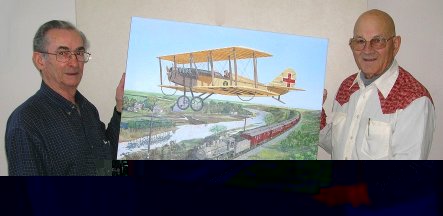
(L) Lindsey Deeprose, in charge of restoration. (R)
Bob Busse, in charge of the archives.
The
Rarely seen WOG Wing
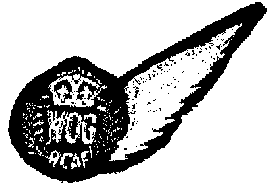 The
usual lettering combination of this RCAF wing creates more questions than
answers. Is it intended to signify “Wireless Operator Gunner” or “Wireless
Operator Ground”?
The
usual lettering combination of this RCAF wing creates more questions than
answers. Is it intended to signify “Wireless Operator Gunner” or “Wireless
Operator Ground”?
The book WINGS – Canada and Great Britain 1913 – 1945
by Warren Carroll, provides the following details:
An example was uncovered in late 1979. It appears to be
of a Canadian manufacture, and may well have been produced in 1943.
The lettering is a mystery, as there is no official reference
to “Wireless Operator Gunner”, though the term “Wireless Air Gunner” is
common, and the “WAG” wing is common in RCAF collections.
To add to the confusion, there was a ”WOG” course lasting
twenty weeks during the Second World War that was shared with some “WAG”
members. And it seems that some Wireless Operators Ground personnel were
occasionally used on training missions during that period – but they were
not entitled to the wing!
Rumours have indicated that some forty-one recipients
were presented with “WOG” wings at a Prince Edward Island training centre,
but, to date, research has failed to confirm this. So the chance is that
a small number of this insignia was produced unofficially.
It is hoped that readers can add some information to clarify
the status of this wing. Has anyone seen it being worn officially, or have
you been the original recipient of such a wing? Comments are welcome.
Submitted by Robert Henderson, Proprietor of HOMEFRONT
ARCHIVES & MUSEUM
60 – 15th Ave.,
Regina, Sk. Canada.
S4T 6V4
(306) 543-5822,
homefront@sasktel.net
CORRESPONDENCE
Good afternoon John.
I had a call this morning from the Westlawn Memorial
Gardens in Edmonton to inform me that they will be unveiling the Veterans
Memorial on June 14 at 1400 hours. This memorial has the names
of most of our AGs both living and deceased and I hope to have a good turn
out from our group. I have already mentioned that it would be nice
if everyone wore their blazer c/w medals. It is the least we can
do I think. Anyway, I plan on taking a few photographs of the event
and maybe a group photo. Would you be interested in a couple of photos
and a short article?? We are also going to the BBQ at the Pioneer
Cabin in Edmonton along with the POWs and the Wartime Aircrew that evening.
I could send you a photo of that event too. Have a nice weekend.
Ted Hackett
Mayday!
Mayday! Mayday!
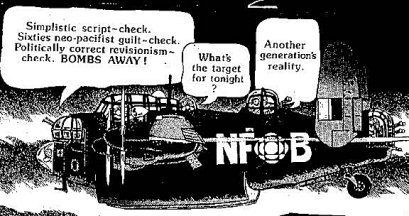
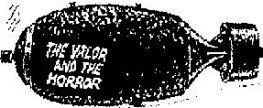
Peterson – Vancouver Sun
It is hard to believe that once gain, as we did with the
McKenna Brother's "Valour and the Horror," we face a challenge by revisionists
who have denigrated the character of those who served in Bomber Command
in World War II.
Below you will find an exact copy of the Plaque leading
into Gallery 3 of the New Canadian War Museum in Ottawa.
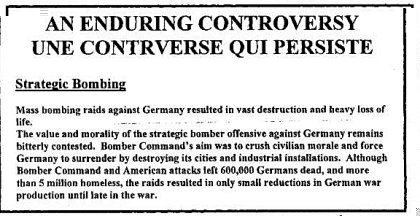
The Plaque purports to sum up the contribution of Allied
Bomber Command Squadrons.
The wording leaves the impression that Allied Bomber Air
Crews and their Commanders were little better than war criminals, intent
on killing, and demolishing homes, leaving the population homeless.
Don Elliot is heading up the committee formed to challenge
this situation. Don, who flew in Bomber Command, was the driving force
involved in the Bomber Harris Trust which challenged the C.B.C and the
McKenna Brothers in a Class action lawsuit.
The following are extracts of a letter to Don Elliot,
written by Claudette Roy, Chair of the Board of Trustees of the War Museum:
………….. “Dr. Rabinovitch has informed me that the story
line presented in Bomber Command is historically accurate and factually
comprehensive………..”
“………… The Board of Trustees has confidence in the information
in the exhibitions and displays of the Canadian War Museum as developed
by staff and management….”
“…. I am aware that my response will probably not satisfy
you and your colleagues in all respects; our military history, as with
all history, remains contested ground….”
So what can we do?
Write a letter to: The Honourable Beverly J. Oda,
Minister of Heritage
15 Eddy St., 12th. Floor,
Gatineau, QC K1A 0M5
Short Bursts thanks Ross Hamilton for alerting our Membership
to this situation.
Editor's
Report
We thank those contributors
who have made this Page possible. Remember, without feed back from our
Members our pages would be blank. Send in your articles, pictures, and
humorous anecdotes for the September Page. Pictures will be scanned and
returned immediately.
During July and August, Doreene and I will be cruising
around the world in our private jet. (If you believe that I have a bridge
in San Francisco I could sell you.)
Have a healthy and active summer. See you in September.
Cheers,
John & Doreene
Moyles
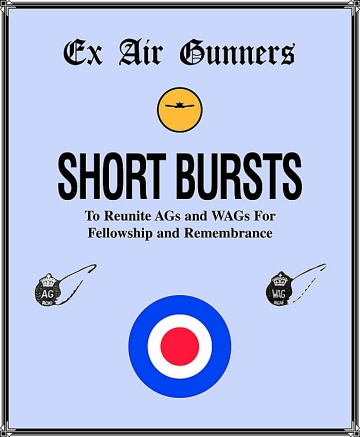






 “The
Germans are advancing, the bridges have to be destroyed at all cost!”
“The
Germans are advancing, the bridges have to be destroyed at all cost!”



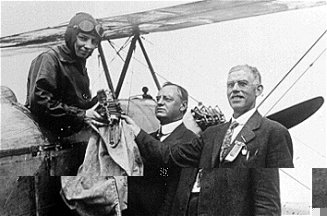






 The
usual lettering combination of this RCAF wing creates more questions than
answers. Is it intended to signify “Wireless Operator Gunner” or “Wireless
Operator Ground”?
The
usual lettering combination of this RCAF wing creates more questions than
answers. Is it intended to signify “Wireless Operator Gunner” or “Wireless
Operator Ground”?



